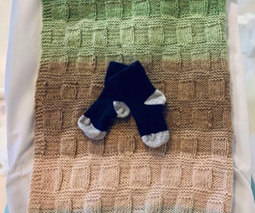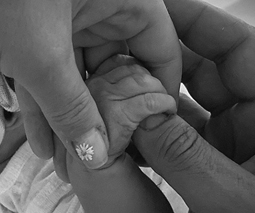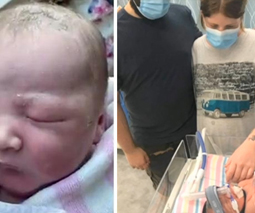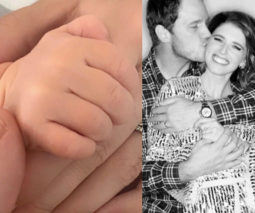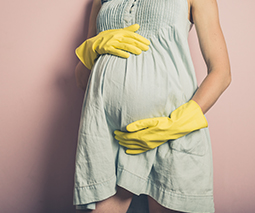What we can learn from THAT birth scene in ‘The Handmaid’s Tale’

No pregnant woman ever thinks they’ll be giving birth by themselves without the aid of medical staff, a partner or even a random stranger. But it DOES happen. Would you know what to do if it happened to you? (Warning: this article contains movie and TV spoilers).
Screen birthing queens
Delivering your baby by yourself seems to be trending right now, both on the big and small screen. First, there was Emily Blunt’s spectacular performance in her hubby’s thriller flick, A Quiet Place, where she gives birth not only completely alone but in SILENCE with monsters hot on her heels. Could you imagine anything worse? And then last week The Handmaid’s Tale offered up Offred, who popped out her precious bub in the middle of nowhere sans help from anyone. Oh, and a hungry wolf waiting nearby. Nice.
Not everyone gives birth like this Serena! via GIPHY
The real deal
While it may seem like the stuff of fiction, there are plenty of women who’ve had to give birth in real life by themselves. One of our own Babyology readers managed it in her lounge room while her husband and toddler were asleep – go, mum! Also, we recently covered the story about a young American woman who did it in a Turkish airport hotel while on a layover to Germany, with only the help of YouTube videos and Google. Talk about savvy!
Read more about amazing births:
- Hello baby! This woman didn’t know she was pregnant – until she gave birth in the bath!
- Miracle birth! Mum delivers her own en caul baby in her car
- Birth goals: Mum has baby in 3 minutes while waiting for car oil change
So, what would you do?
While women around the world have probably been delivering their babies alone in fields and jungles for centuries, if the mere thought of it happening to you sparks a crippling panic attack then this is for you. Just in case you suddenly find yourself in emergency labour with no one else around, here’s what you need to do.
1. Confirm your status
In some cases where women have given birth by themselves, they’ve ignored early signs that they were in labour, leaving it too late to get to a hospital or get help. If you have strong, regular contractions (pain in your tummy and/or back!), your waters have broken (clear or yellow fluid in your pants), you feel like pushing, or your cervix has dilated (the Lord “has opened” down below) – ring a doctor immediately.
2. Call for help
Don’t try to be a hero. Think about the safety of you and your baby and ring 000 or someone else for help. Not only will they send an ambulance but you could talk to someone for support and guidance on what to do next. If you’re not near a phone, try using a computer or tablet to reach someone … or some good old-fashioned shouting.

3. Get safe and comfortable
Find a safe, clean spot to give birth (e.g. if you’re driving, for heaven’s sake pull over!). If you’re at home find some blankets, sheets or towels to lay down, as things are going to get pretty messy. Running a bath might sound tempting, but this might not be the most comfortable or safest option for you. It varies with each woman and baby. Generally, the best positions for pushing out a baby with no assistance are lying on your left side, squatting or on all fours.
4. Stay calm
Easier said than done, we know, but remember this is a completely natural part of life. Just think about those women out in the fields. The more relaxed you are, the safer it is for the baby and the easier your labour will be. Also, most bubs who arrive quickly are in the prime birthing position, with their heads facing down (which is why it happens so fast), so the risk of coming out feet first is not as high.
5. Take it slow
In your state of panic, the desire to get the baby out as fast as possible may cause you to push hard and fast but this can cause damage down below, so it’s best to take it easy. Don’t be frightened if you see lots of blood either (a la Offred’s – sorry JUNE’s – situation). While this isn’t typical, it doesn’t always mean there is something wrong. You may have torn your cervix or vagina. Once you feel the baby’s head emerge, gently hold it and guide your baby out – no pulling. Make sure you’re looking, too, because if the umbilical cord is around her neck you will need to place a finger underneath and lift it over her head.

6. Post-birth steps
Once the baby has arrived, lift her up to your chest for some skin-to-skin contact, clean her a little (if necessary), and check that she’s breathing. If she doesn’t seem to be, encourage this by rubbing the back of her ribcage and placing her head lower than her feet. You may need to clear her mouth out too. Once she is breathing on her own, place your baby’s mouth on your nipple to commence breastfeeding. Don’t worry you won’t have milk yet, instead, a thick nutrient-dense substance called colostrum. Great for bonding, more importantly, this act will release more oxytocin which will help your uterus contract and naturally deliver your placenta. Yes, unfortunately, you’re not done yet and you’ll feel more contractions until this is out.
7. Rest and wait
The hard part is over so don’t attempt to do anything else yourself like cutting the cord or placenta. Infections can occur or your baby’s breathing might be affected if done incorrectly. Continue breastfeeding, keep yourself and your baby warm, rest and wait for help to arrive (assuming you followed step number one!).
Did you give birth alone? What was your experience like? Tell us your story on our Facebook page.




